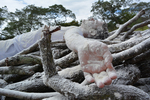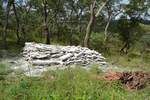WHITE ELEMENT 11
White element 11 (19-26/ 3-2017) Subtitle: Several ways to deal with a "readymade". Forrest reserve Lusaka, Zambia Mixed media: Performance, wood pile (dimensions: 486cm L x 258cm W x 104cm H), maize and cassava flour. Dressed in white (being his alter ego) makes Camilio a true part of the art work / performance.
dated 2017 until 2017
(click on an image to enlarge an artwork)
send a message

Readymade, captured
2017
Art project picture 01
The wood pile found on a walk in the forest, as it was, "just a wood pile".
dimensions: 486cm L x 258cm W x 104cm H
White element 011
Subtitle: Several ways to deal with a "readymade".
Forrest reserve Lusaka, Zambia
Mixed media: performance, wood pile (dimensions: 486cm L x 258cm W x 104cm H) with maize and cassava flour.
19-26 March 2017
For viewing the performance film, klick on this "picture and text" page and you will find the link to You Tube. If (by clicking) you came on that "enlarged picture page" please scroll down on this window to find the film.

Being one
2017
Art project picture 02
After the wood pile was found in the forest, I decide how it felt to ly on the wood pile, beeing one with the pile of wood and the surrounding it was in.
3 ways of dealing with a readymade object, found in a forest showing human demolition of trees to make way for roads in an attempt to make a residential area in a protected forest area. In other words: showing the rapid growth of a city and bad “human city planning”, a protected forest area has to make way.
Deforestation is the main focus in this art project where I “investigated” tree ways to handle with this ready-made rectangular object. Looked at it from another angle we could say it is a symbolic and ritualistic way to “mourn” about the loss of these trees in a country (Zambia) where 90% of the people are believing in a self-proclaimed Cristian nation failing to protect the environment and its animal wildlife, especially when it is a borderline case. We could also questioned what is mourned here: that the trees are illegally demolished in particular or that the people are unable to be strict about the borders of a protected forest area.
For viewing the performance film, klick on this "picture and text" page and you will find the link to You Tube. If (by clicking) you came on that "enlarged picture page" please scroll down on this window to find the film.

Being baptized 01
2017
Art project picture 03
After being one with the wood pile for a while I returned in white, lay down again in on other posture after I was being baptized with maize flour and cassava flour.
Deforestation is the main focus in this art project where I “investigated” tree ways to handle with this ready-made rectangular object. Looked at it from another angle we could say it is a symbolic and ritualistic way to “mourn” about the loss of these trees in a country (Zambia) where 90% of the people are believing in a self-proclaimed Cristian nation failing to protect the environment and its animal wildlife, especially when it is a borderline case. We could also questioned what is mourned here: that the trees are illegally demolished in particular or that the people are unable to be strict about the borders of a protected forest area. When you always give way on a borderline case in loss for nature, where will it end? Making a site specific artwork on this found object, or call it readymade art, was a bless to me, but will it be a bless to humankind remains the question.
Using Maize and Cassavas flour in this combination I hope will provoke the discussion (in Zambia and Malawi at least) what is cultural staple food/eating tradition or “forced on” tradition, or at least know what your history is and tell (remember) it correctly. If I do I do that myself is one my quest as well, but I try my best. There are traces found in the history of maize flour stating this food was even brought in to Africa through the slave traders, well, I only know of what I read that maize plants are cultivated in South-America before the maize plants (and maize flour) reached Africa.

Being baptized 02
2017
Art project picture 04
After being one with the wood pile for a while I returned in white, lay down again in on other posture after I was being baptized with maize flour and cassava flour.
Deforestation is the main focus in this art project where I “investigated” tree ways to handle with this ready-made rectangular object. Looked at it from another angle we could say it is a symbolic and ritualistic way to “mourn” about the loss of these trees in a country (Zambia) where 90% of the people are believing, in a self-proclaimed Cristian nation, failing to protect the environment and its animal wildlife, especially when it is a borderline case. We could also questioned what is mourned here: that the trees are illegally demolished in particular or that the people are unable to be strict about the borders of a protected forest area. When you always give way on a borderline case in loss for nature, where will it end? Making a site specific artwork on this found object, or call it readymade art, was a bless to me, but will it be a bless to humankind remains the question.
Using Maize and Cassavas flour in this combination I hope will provoke the discussion (in Zambia and Malawi at least) what is cultural staple food/eating tradition or “forced on” tradition, or at least know what your history is and tell (remember) it correctly. If I do I do that myself is one my quest as well, but I try my best. There are traces found in the history of maize flour stating this food was even brought in to Africa through the slave traders, well, I only know of what I read that maize plants are cultivated in South-America before the maize plants (and maize flour) reached Africa.

Baptizing
2017
Art project picture 05
After 'I' was being baptised on the pile of wood and walked of, I returned with more maize flour and cassava flour to baptizing the woodpile until it totally turned white, into a white element, my eleventh white element I created in my artist career.
Working with maize and cassava flour makes it even more site specific because these crops are the main reason of deforestation as agriculture land is all too often created by cutting down forests. But I also mean it here in an economic and political way. For example: Corn flour (white) in Zambia and Malawi are subject of political influence (price and distribution) and corruption (in Malawi there is a food shortage right now (rain season 2017) because the emergency stock (enough for 3 years) was sold before there was an emergency, to benefit a few). A more personal observation (but far more less worse that the first): in the village we stayed in Zanzibar we were drinking instant coffee while they grow coffee there but it was not for sale in the surrounding islands and villages because it is to expansive to them. Saying they are cheap labour, but not given what they harvest, because it is meant for export and others to make more profit. This effect is also seen a lot in the ‘cacao beans farming’.
As we all know the same food items are not equally distributed all over the world mainly because of a strange and complex combination of supply and demand, politics, international economy, local economy and/or due to high transport costs (especially when a country is land locked).